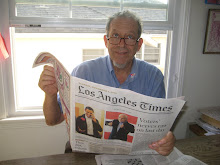EAU DE NEW JERSEY
Mysteriously, there rose a smell
in Bergen County, and it crossed
the Hudson River, where its spell
on Westside people was not lost,
but those puzzled were not able
to find its source. Some wiseguys said:
“This must be syrup made from maple,”
but to pancakes they weren’t led,
because it came not from Vermont,
as you might think, but from the State
that’s called a Garden, and the font
of Mafiosi who seem great
on television, but are less
inspiring in real life––the show
that glamorized New Jersey’s mess
less FBI than HBO.
The smell did not come from Sopranos,
but fenugreek. Next time you cross
the Hudson, and you’ve no catarrh-nose,
and feeling lost, you wonder if
you should have left Manhattanland,
don’t keep the windows closed but sniff
and see if you can understand
why Jersey smells can’t be forgotten,
not even in the Upper West-
side or the Eastside, where what’s rotten
are funds where only fools invest.
When trying to escape the reek
of Madoff madness, try to find,
the pheromone called fenugreek
which can assuage the mapled mind.
It’s in a perfume, naughty, new,
eau de New Jersey, and I’ll sell
you shares I guarantee to you
will make you gelt that doesn’t smell.
Michael Barbaro and Nate Schweber write about a mysterious smell in Manhattan (“To Solve Mystery Smell: Catch It, Send It to a Lab and Sniff Across the Hudson”) in the NYT, February 6, 2009, about a mysterious smell:
Baffled city investigators began calling them “maple syrup events”: mysterious waves of sweet-smelling air that periodically wafted over Manhattan, delighting some, troubling others and vanishing as quickly as they had arrived. After each episode — in 2005, 2006 and again this year — residents flooded the city’s 311 information hot line with calls. The city’s Department of Environmental Protection dispatched air testers. But nobody could pinpoint the smell — or its source. So the aroma was filed away as another vexing urban mystery, never to be solved. Until now. The city revealed on Thursday that the culprit was the seeds of fenugreek, a cloverlike plant, which are used to produce fragrances at a factory across the Hudson River in North Bergen, N.J. It turned out that the city had never given up trying to determine the aroma’s origin. It had quietly created a crack maple-syrup team that remained on the case. The North Bergen factory, owned by a company called Frutarom, used the herbal seeds to manufacture food flavors, releasing a pungent, generally pleasant smell in the process. Under the right weather conditions — high humidity, no rain — the aroma drifts across the Hudson onto the West Side of Manhattan. “I think it’s safe to say that the mystery of the maple syrup mist has been solved,” Mayor Michael R. Bloomberg said at a news conference at City Hall, cautioning that the city was still investigating several leads. Fenugreek produces seeds and leaves that are used in a variety of cuisines, and are believed to have health benefits, like improving milk production in new mothers. Frutarom, which is based is Israel, appeared to be blindsided by the mayor’s announcement. In a statement, the company said its apparent contribution to the recurring odor “came as a surprise to us.” Mr. Bloomberg said the company did not appear to have violated any laws. But Frutarom’s factory has previously been penalized by the New Jersey Department of Environmental Protection. In 2006, it ordered Frutarom to pay a fine of nearly $450,000 for water and air quality violations, an agency spokeswoman said. At the New Jersey factory on Thursday, the air was thick with a candylike scent. A secretary said, “Nobody has ever complained about the smells.”… An analysis of all known maple syrup smell incidents revealed telling trends. Most of the complaints came from the Upper West Side and Morningside Heights. At the time, winds blew at a similar speed, from the west, “indicating that the source of the mysterious odor was Hudson or Bergen Counties in New Jersey,” Mr. Bloomberg said. The city’s Office of Emergency Management compiled a list of a dozen potential factories, three of which produced fragrances or food additives. Working with New Jersey environmental officials, city investigators narrowed the list to one — Frutarom, which had processed the seeds on Jan. 29. Neighbors of the factory were not surprised to hear about the traveling aroma. Chris Jenkins, 34, plant manager at North Bergen Asphalt Products, right next to Frutarom, said he detected the scent all day. “For the most part the smells are actually quite enjoyable,” he said. “Ooh, it makes you hungry.” Depending on the day, he said, the smell resembles pancake syrup, cookies or fruit. None of those who work nearby seemed alarmed by the smell, and several wondered why Manhattanites, who lived considerably farther away, would complain about it. “New Yorkers smell a little smell and they’re getting all paranoid,” said Jay Beqej, 33, who works at the Fairview Public Works warehouse.
© 2009 Gershon Hepner 2/6/09
Sunday, February 8, 2009
Subscribe to:
Post Comments (Atom)


I think smells make life more interesting for the most part. But I attend a local church where, if they can smell you, a witch hunt develops to find the culprit who spritzed on too much smelly stuff. It's quite horrendous watching them nosing you out like a pack of hounds. In self defense I now have a whole collection of baby colognes and other innocuous scents (and yes, they even complain about some of those, probably because they can still smell it if they stand less than 12 inches away).
ReplyDeleteAt least it wasn't the economy reeking (yet).
testing. great piece my friend
ReplyDeleteLeslie
A very nice creative write about the mysterious smell of maple syrup. Informative article indeed,Thanks for the lovely read...
ReplyDelete